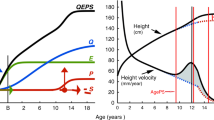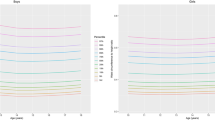Abstract
Objective: To demonstrate sexual dimorphism in serum leptin levels not only during puberty, but also in childhood in Japan.
Design: Cross-sectional study.
Setting: Hamamatsu-Hokuen study in Japan.
Subjects: Body weight and height were measured in normal-weight Japanese children and adolescents (143 boys, 178 girls), and 161 boys and 129 girls whose percentage of overweight for the standard (%Wt) was more than+25%. Serum leptin levels were compared with %Wt. Subjects were divided into group 1 (6–10 y of age) and group 2 (11–15 y of age) according to their age.
Results: In overweight subjects, leptin was more highly correlated with %Wt in boys of group 2 (r=0.67, P<0.0001) than group 1 (r=0.32, P=0.004). In girls as well, a correlation coefficient was greater in group 2 (r=0.67, P<0.0001) than group 1 (r=0.44, P=0.0011). In normal-weight boys, there was no significant correlation between serum leptin and %Wt both in groups 1 and 2. On the contrary, statistical significance was demonstrated in the correlation between serum leptin and %Wt in group 1 (r=0.31, P=0.0019) and group 2 (r=0.35, P=0.0014) as well as in the total normal-weight girls (r=0.28, P=0.0011).
Conclusions: It is suggested that sexual dimorphism is present in serum leptin levels, especially when compared to weight, as early as during childhood.
European Journal of Clinical Nutrition (2001) 55, 989–993
This is a preview of subscription content, access via your institution
Access options
Subscribe to this journal
Receive 12 print issues and online access
$259.00 per year
only $21.58 per issue
Buy this article
- Purchase on Springer Link
- Instant access to full article PDF
Prices may be subject to local taxes which are calculated during checkout
Similar content being viewed by others
References
Ahmed ML, Ong KKL, Morrell DJ, Cox L, Drayer N, Perry L, Preece MA & Dunger DB (1999) Longitudinal study of leptin concentrations during puberty: sex differences and relationship to changes in body composition J. Clin. Endocrinol. Metab. 84 899–905
Austin H, Austin JM Jr, Partridge EE, Hatch KD & Shingleton HM (1991) Endometrial cancer, obesity and body fat distribution Cancer Res. 51 568–572
Blum WF, Englaro P, Hanitsch S, Juul A, Hertel NT, Muller J, Skakkeboek NE, Heiman ML, Birkett M, Attanasio AM, Kiess W & Rascher W (1997) Plasma leptin levels in healthy children and adolescents: dependence on body mass index, body fat mass, gender, pubertal stage, and testosterone J. Clin. Endocrinol. Metab. 82 2904–2910
Butte NF, Hopkinson JM & Nicolson MA (1997) Leptin in human reproduction: serum leptin levels in pregnant and lactating women J. Clin. Endocrinol. Metab. 82 585–589
Carlsson B, Ankarberg C, Rosberg S, Norjavaara E, Albertson-Wikland K & Carlsson LMS (1997) Serum leptin concentrations in relation to pubertal development Arch. Dis. Child. 77 396–400
Eiholzer U, Blum WF & Molinari L (1999) Body fat determined by skinfold measurements is elevated despite underweight in infants with Prader–Labhart–Willi syndrome J. Pediatr. 134 222–225
Elimam A, Lindgren AC, Norgren S, Kamel A, Skwirut C, Bang P & Marcus C (1999) Growth hormone treatment downregulates serum leptin levels in children independent of changes in body mass index Horm. Res. 52 66–72
Franceschini R, Corsini G, Cataldi A, Fiorucci A, Tenerelli P, Rolandi E & Barreca T (1999) Twenty-four-hour variation in serum leptin in the elderly Metabolism: Clin. Exp. 48 1011–1014
Gasser T, Kniep A, Ziegler P, Molinari L, Prader A & Largo R (1994) Development and outcome of indices of obesity in normal children Ann. Hum. Biol. 21 275–286
Halaas JL, Gajiwala KS, Maffei M, Gohen SL, Chait BT, Babinowitz D, Lallone RL, Burley SK & Friedman JM (1995) Weight-reducing effects of the plasma protein encoded by the obese gene Science 269 543–546
Hanaki K, Becker DJ & Arslanian SA (1999) Leptin before and after insulin therapy in children with new-onset type 1 diabetes J. Clin. Endocrinol. Metab. 84 1524–1526
Kuromaru R, Kohno H, Ueyama N, Hassan HM, Honda S & Hara T (1998) Long-term prospective study of body composition and lipid profiles during and after growth hormone (GH) treatment in children with GH deficiency: gender-specific metabolic effects J. Clin. Endocrinol. Metab. 83 3890–3896
Malina RM, Zavaleta AN & Little BB (1986) Estimated overweight and obesity in Mexican American school children Int. J. Obes. 10 483–491
Montague CT, Farooqi IS, Whitehead JP, Soos MA, Rau H, Wareham NJ, Sewter CP, Digby JE, Mohammed SN, Barnett AH, Prins JB & O'Rahilly S (1997) Congenital leptin deficiency is associated with severe early-onset obesity in humans Nature 387 903–908
Nagy TR, Gower BA, Trowbridge CA, Dezenberg C, Shewchuk RM & Goran MI (1997) Effects of gender, ethnicity, body composition, and fat distribution on serum leptin concentrations in children J. Clin. Endocrinol. Metab. 82 2148–2152
Nakanishi T, Takeuchi H, Nakagawa Y, Toya K, Endoh A, Nasuda K, Saegusa H, Inaba Y & Ohzeki T (1999) Sex differences in leptin concentrations and their relation to weight indices in children and adolescents Horm. Res. 51 12 4 (abstract).
Ohzeki T, Hayashi K, Higurashi M, Hanaki K, Ishitani N & Shiraki K (1989) Ullrich–Turner syndrome and anorexia nervosa Am. J. Med. Genet. 32 87–89
Ohzeki T, Hanaki K, Motozumi H, Ishitani N, Matsuda-Ohtahara H, Sunaguchi M & Shiraki K (1990) Prevalence of obesity, leanness and anorexia nervosa in Japanese boys and girls aged 12–14 y Ann. Nutr. Metab. 34 208–212
Ohzeki T, Hanaki K, Motozumi H, Matsuda-Ohtahara H & Shiraki K (1992) Skinfold thickness at ulnar, triceps, subscapular, and suprailiac regions in 1,656 Japanese children aged 3–11 y Ann. Nutr. Metab. 36 251–256
Ohzeki T, Hanaki K, Ishitani N, Ohtahara H, Urashima H, Tsukuda T, Nagaishi J & Shiraki K (1995) Usefulness of a stature-based standard of skinfold thickness, especially for short children Am. J. Hum. Biol. 7 237–240
Ohzeki T, Hanaki K, Tsukuda T, Urashima H, Ohtahara H, Tanaka Y, Nagaishi J & Shiraki K (1996) Fat areas on the extremities in normal weight and overweight children and adolescents: comparison between age-related and weight-related changes in adiposity Am. J. Hum. Biol. 8 427–431
Rolland-Cachera MF, Sempé M, Guilloud-Bataille M, Patois E, Pequignot-Guggenbuhl F & Fautrad V (1982) Adiposity indices in children Am. J. Clin. Nutr. 36 178–184
Saad MF, Damani S, Gingerich, Riad-Gabriel MG, Kahn A, Boyadjian R, Jinagouda SD, El-Tawil K, Rude RK & Kamdar V (1997) Sexual dimorphism in plasma leptin concentration J. Clin. Endocrinol. Metab. 82 579–584
Tanner JM & Whitehouse RH (1975) Revised standard for triceps and subscapular skinfolds in British children Arch. Dis. Child. 50 142–145
Tsukuda T, Hanaki K, Ohzeki T, Ohtahara H, Urashima H & Shiraki K (1994) Obesity in young children aged 3 to 6 y can be easily screened by measurement of bioelectrical impedance Int. J. Obes. Relat. Metab. Disord. 18 (Suppl 2), S 9 (abstract).
Wolthers OD, Heuck C & Skjaerbaek C (1999) Diurnal rhythm in serum leptin J. Pedatr. Endocrinol. Metab. 12 863–866
Yang SW & Kim SY (2000) The relationship of the levels of leptin, insulin-like growth factor-I and insulin in cord blood with birth size, ponderal index, and gender difference J. Pediatr. Endocrinol. Metab. 13 289–296
Zhang Y, Proenca R, Maffei M, Barone M, Leopold L & Friedman J (1994) Positional cloning of the mouse obese gene and its human homologue Nature 372 425–432
Acknowledgements
This work was supported in part by grants from The Japanese Ministry of Health and Welfare (Research on Children and Families, Chiefs, Professor N Matsuura and Professor K Kida) and Japan China Medical Association (Tokyo, Japan). We would like to thank Professor T Matsumoto and Professor M Arakida (Department of Nursing) and Professor M Kanamori (Department of Public Health) for their cooperation.
Author information
Authors and Affiliations
Corresponding author
Rights and permissions
About this article
Cite this article
Nakanishi, T., Li, R., Liu, Z. et al. Sexual dimorphism in relationship of serum leptin and relative weight for the standard in normal-weight, but not in overweight, children as well as adolescents. Eur J Clin Nutr 55, 989–993 (2001). https://doi.org/10.1038/sj.ejcn.1601257
Received:
Revised:
Accepted:
Published:
Issue Date:
DOI: https://doi.org/10.1038/sj.ejcn.1601257
Keywords
This article is cited by
-
Construction and identification of lentiviral RNA interference vector of rat leptin receptor gene
Frontiers of Medicine in China (2009)



